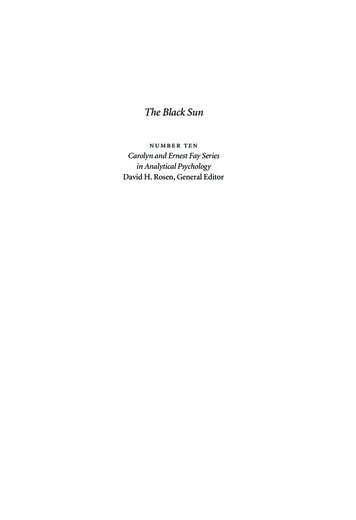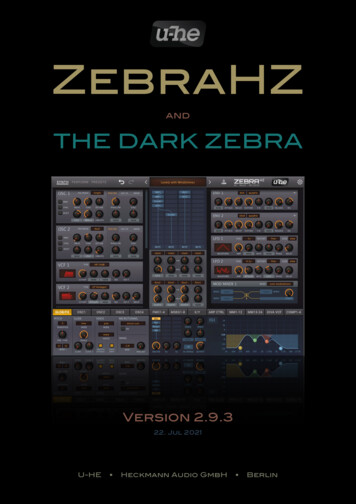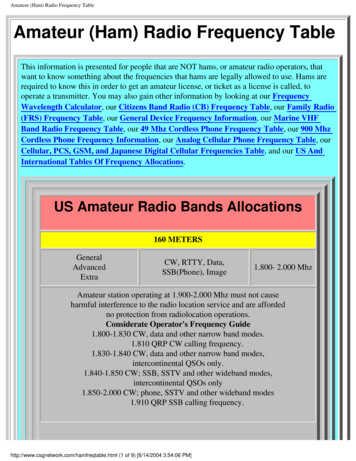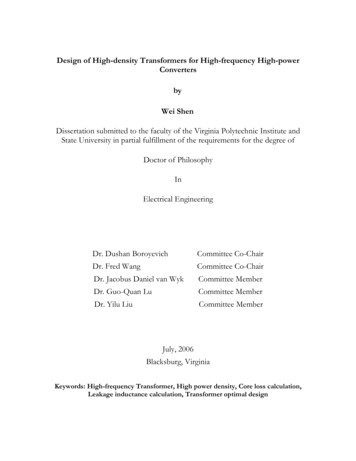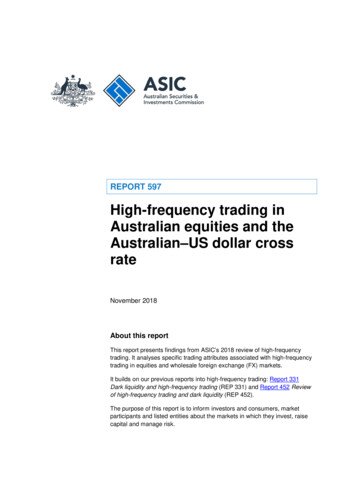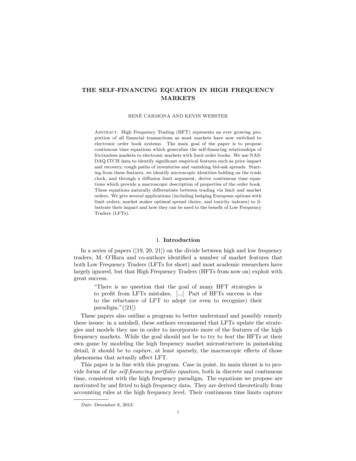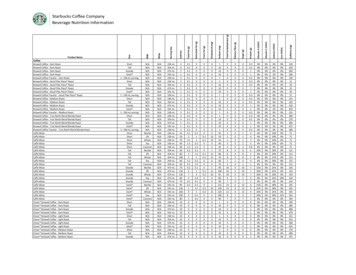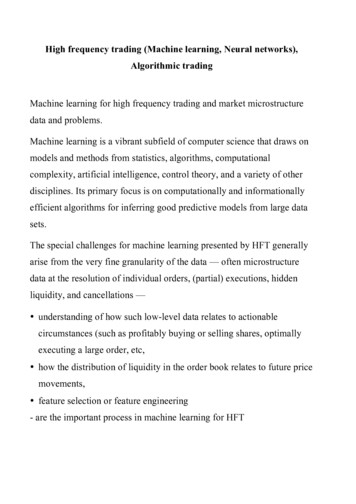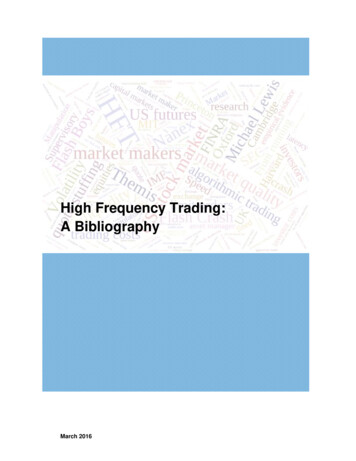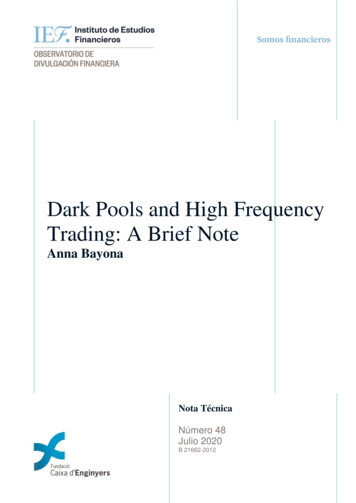
Transcription
Dark Pools and High FrequencyTrading: A Brief NoteAnna BayonaNota TécnicaNúmero 48Julio 2020B 21662-2012
IEF Observatorio de Divulgación FinancieraFinancial markets have experienced many changes over thelast two decades. This note will focus on explaining two aspectsthat have undergone a significant change in the trading offinancial securities: market structure and trading strategies.Even though these topics apply more generally to many assetclasses, this note will focus especially on stocks (equities).1.Market Structure and dark poolsThere are currently many trading venues for executinginvestors’ orders, as markets have become fragmented. Prior tothe 2000s, the broker would have most likely traded the securityin the venue where the security was listed (in the US, this wouldbe either the New York Stock Exchange or the Nasdaq). Today,the decision on where to send an investor’s order is complexand brokers often use algorithms to achieve the best execution.The broker can send the investor’s order to three main typesof marketplaces. First, the broker can send the order to anexchange, where bids and offers are mostly visible and can bematched and executed. Exchanges are regulated in variousdimensions. These include restrictions on who can trade; aclearly defined trading procedure which is transparent (visibilityof the order flow or part of it); requirements on which financialinstruments are admitted; and requirements imposed by issuersof securities and trading members. Second, the broker can sendthe order to alternative trading systems (ATS), which are alsocalled multilateral trading facilities in Europe, which are morelightly regulated than exchanges, especially in terms ofdisclosure requirements. The most important types of ATS aredark pools. The reports by Rosenblatt Securities (2019) statethat currently the US has more than 30 dark pools, whichaccount for 14.1% of the US consolidated trading volume (inEurope, dark pools account for 4.7% of the volume). Third, theorder can also be traded in other off-exchange alternatives,such as a systemic internaliser, or trade it over the counter.Systemic internalisers cross traders’ orders internally with othertraders’ orders or with proprietary positions.The origins of off-exchange trading are as old as exchangesthemselves. Historically, “upstairs” trading would occur whentwo institutions with large trading intentions (block trades) wouldnegotiate privately and away from exchanges in order to haveless price impact and reduce transaction costs1. In the late1990s, technological innovations related to electronic tradingand the regulatory environment made it possible to haveorganised dark pools. Banks (2014) makes the followingdefinition: “A dark pool is a venue or mechanism containinganonymous, non-displayed, trading liquidity that is available forexecution”. Let us now discuss the main characteristics of darkpools2.1A block trade in stocks generally involves trading at least 10,000 shares of non-pennystocks.Dark pools do not display lists of buy and sell orders for afinancial security (that is, price and volume). In other words, theorder book is not visible, hence dark pools are opaque andanonymous3. This feature allows large institutional investors toplace orders in dark pools without revealing information to themarket, thus precluding the possibility of unfavourable pricemovements. In addition, most dark pools would execute a blocktrade at a price, thus minimizing the slippage. Despite the lackof pre-trade transparency, dark pools are required to reporttrades after they have occurred.Dark pools’ pre-trade opacity has an impact on the overalltransparency of the market and affects the price discoveryprocess. Zhu (2014) finds that adding a dark pool alongside anexchange does not reduce price discovery, since informedinvestors tend to concentrate on exchanges. Bayona et al.(2014) find that the effects on market quality are subtle andthese depend on stock and trader characteristics. Regulatorsare especially concerned about how this aspect of dark poolsand the fragmentation of equity markets affect market quality.In terms of pricing, most dark pools generally offer a priceimprovement over displayed quotes on exchanges. Some darkpools offer only a small price improvement, while others pricetheir quotes at the mid-point between the bid and the ask pricesin the exchange, where both a buyer and seller get morefavourable prices in the dark pool compared to an exchange. Assuch, dark pools use exchanges to derive their transactionprices. In addition, dark pools typically do not charge tradingfees, and thus offer lower explicit transaction costs than mostexchanges.However, dark pools do not guarantee the execution of theorders sent to them, i.e., there is execution risk. In order toimprove their liquidity, some dark pools have allowed orders ofsmaller sizes. Since their origins, the average trade size of darkpools has declined dramatically, from very large blocks tocurrently an average trade size which is very similar to theaverage exchange trade size. This indicates that some darkpools attract not only institutional investors but also other typesof traders.Another important dimension is their ownership structure.According to Rosenblatt Securities (2019), in the US, 62% of thedark pool trading volume is operated by investment banks owndark pools (e.g. UBS ATS, Credit Suisse CrossFinder, orMorgan Stanley MS Dark Pool). These institutions trade onbehalf of their clients, but also make their own proprietarytrades. Another type of ownership structure is when the darkpool acts solely as agent of their clients. These include agencybroker dark pools (Virtu Posit or Liquidnet) and exchangeowned dark pools (BATS Trading or NYSE Euronext). Finally,there are also market-maker dark pools with 17% of the dark2Dark pools are horizontally differentiated in several dimensions, such as pricing,matching process, types of orders allowed, and assets traded, among others.3There are also non-displayed orders on exchanges. See more at OECD (2016).1
IEF Observatorio de Divulgación Financierapool market share (e.g., Citadel Connect). In Europe, the marketstructure of dark pools by type of operator is rather different, withthe largest percentage being owned by exchange multilateraltrading facilities, with 43% of trading volume, such as CBOEDark or Turquoise Plato.programmed set of rules that establishes which, when, in whichvenue, and how to trade financial securities, and other marketproducts such as currencies and commodities. Algorithmictrading strategies are now sophisticated, complex, and theyadapt to new market conditions.Finally, dark pools may be subject to conflicts of interest.The dark pool operator may be able to conceal prices and/orpriority, especially since the order book is not visible ex-ante tomarket participants. Another potential conflict of interest,especially related to investment banks’ own dark pools, is thatthey may not route clients’ orders to the trading venue whichguarantees the best possible price for a financial asset, thusviolating the best execution rule.An important type of algorithmic trading strategy is highfrequency trading (HFT), where trading occurs over very shortintervals of time, nowadays to the order of a microsecond (thereare a million microseconds in 1 second). These strategiesdepend on computational power, algorithm sophistication, fastaccess to data (usually achieved through physical proximity tothe exchange venue, also called co-location), and informationprocessing capacity. As a result of these developments, thedefinition of speed in financial markets has greatly changed inthe last few years. Aquilina et al. (2020) cite that this method oftrading currently represents around 50% in US markets or more,even though it is difficult to quantify precisely. Typicalcharacteristics of HFTs include high speeds, high tradingvolumes, and take advantage of very short-term profitopportunities (often intraday ones).The regulation of dark pools has evolved over time, andvaries across different geographical areas. In the US, theSecurities and Exchange Commission (SEC) introduced aregulation for Alternative Trading Systems (ATS) in 1998. Thisregulation imposed stricter rules on record keeping andtransparency requirements once dark trading exceeded 5% ofthe average daily trading volume of a single stock. However, thisregulation did not prevent predatory behaviour and conflicts ofinterest, which have led to various lawsuits. Between 2011 and2018, banks and brokers have paid more than 229 million inpenalties for misconduct related to dark pools. In 2018, the SECvoted to improve the oversight of dark pools, especially withregards to operational transparency.In Europe, the relevant regulations are the Markets inFinancial Instruments Directive II (also known as MiFID II) andMarkets in Financial Instruments Regulation (also known asMiFIR), which were approved in 2014 and implemented at thebeginning of 2018. These regulations have the objective toensure fairer, safer, more efficient markets and to providegreater transparency to all market participants. Theseregulations incorporate the Double Volume Cap (DVC)mechanism to limit the amount of trading in dark pools. Thereare two caps: the first, limits the percentage of trading in aninstrument on a single trading venue to 4%, and the secondlimits the percentage of trading of an instrument on all tradingvenues to 8% of the total trading volume during the last year onall the EU trading venues. However, the European Securitiesand Markets Authority (ESMA) is currently evaluating the actualimpact of these regulations since their implementation andconsidering potential modifications.2.Trading strategiesThe recent innovations in trading strategies are mainlyrelated to algorithmic trading and high frequency trading (HFT).Algorithmic trading is a method for buying or selling financialsecurities that is nowadays prevalent in financial markets 4.Algorithmic trading is any method that makes use of a pre-The popular and academic literature has debated the impactof HFTs on markets. The popular books of Patterson (2012) andLewis (2014) claimed that the rise of algorithmic trading, HFTsand dark pools had rigged markets. With regards to theacademic literature, Menkveld (2016) summarises the empiricaland theoretical evidence of the effect of HFTs on market quality.His main points are that: (i) in the decade of the rise of electronictrading and HFT, transaction costs have decreased over 50%for both retail and institutional investors; (ii) there is evidencethat, beyond being very fast, HFTs are also well-informed, andare often mostly market-makers. As a result, HFTs tend toreduce transaction costs; (iii) when HFTs prey on largeinstitutional orders, they increase transaction costs. Examplesof these predatory practices include HFTs using information(which they sometimes pay to obtain earlier than other investorsusing public feeds) and speed to front-run large institutionalorders. In addition, HFTs may use pinging, which involvessending multiple small orders to determine whether there arelarge buy or sell orders in a specific trading venue. (iv) HFTsenable competition in trading venues; (v) HFTs help investorsrebalance their portfolios by generating more opportunities.Biais and Foucault (2014) argue that the impact of HFT onmarket quality depends critically on the type of HTF strategyused, and that these strategies are heterogeneous. The fivemain types are: market-making (mainly submitting limit ordersthat supply liquidity), arbitrage (exploiting arbitrageopportunities), directional trading (taking a directional stake inan asset anticipating price movements), structural (takingadvantage of specific market characteristics) and manipulation(artificially influencing the market or the price of an asset).Empirical evidence has found that HFT market orders contain4In some markets, it is estimated that algorithmic trading is around 70% (EuropeanCentral Bank, 2019).2
IEF Observatorio de Divulgación Financierainformation and there are positive profits associated to them,while limit orders usually lead to negative profits. Furthermore,Biais, Foucault and Moinas (2015) claim that fast access tomarkets can reduce costs of intermediation, which is beneficial,but can also generate adverse selection, since some marketparticipants have faster access than slower ones, which isdetrimental to market efficiency. These characteristics of HFTsmight generate negative externalities such as lower “slowtrader” market participation, an excessive investment in tradingtechnologies, and an increase in systemic risk.An example of a situation in which HFTs were related to anincrease in systemic risks is the Flash Crash of 2010. In this 36minute episode, the US stock markets collapsed and recovered,generating extreme market volatility. A study of the abovementioned flash crash by Kirilenko et al. (2017) concluded thatHFTs did not trigger the Flash Crash, but that they exacerbatedmarket volatility by responding to huge selling pressures on thatday. So, even if HFTs increase liquidity in normal times, HFTsdo not provide liquidity in episodes of crashes.Current regulation of algorithmic trading, which includesHFT, in the US and Europe requires compliance in terms ofgovernance, staffing, information technology, testingalgorithms, resilience, surveillance, plans for dealing withdisruptive episodes, trading controls, security and reporting. Inaddition, for HFTs that are market-makers there are otherrequirements in terms of liquidity provisions to the tradingvenue. Furthermore, algorithmic traders have to comply withregulatory capital requirements, which applies to all tradinginstitutions. Further academic proposals to regulate HFT haveincluded institutional changes in the current market structure,such as to have periodic call auctions replacing the continuoustrading and conducting stress tests to evaluate the systemicrisks they pose.3.sued Barclays for its dark pool operations, specifically formisstating the level of HFT activity in its dark pool, thusdefrauding investors. In January 2016, Barclays agreed to paya fine of 35 million to the SEC and 70 million to the New YorkAttorney General for its misconduct related to the dark pool.There are some controls that dark pools can impose to avoidpredatory practices by HFTs. Petrescu and Wedow (2017)propose several, such as to impose a minimum order size,which is intended to reduce pinging strategies to a minimum, ormatching orders at discrete points in time rather than usingcontinuous crossing. However, not all dark pools wish to avoidHFTs, and this is acceptable as long as investors accuratelyknow how trading venues operate so they can make informeddecisions.4.Concluding remarksThe changes in financial markets in the last twenty yearshave had many positive aspects that need to be stressed: fasterprocesses, more competition, higher product differentiation, andgreater operational efficiency. However, this article has brieflydiscussed how dark pools and high frequency trading strategiescan also potentially lead to a deterioration of market quality.Regulators around the world have already implemented or areconsidering several measures to address the market failuresthat dark pools and HFTs might lead to. These regulations needto keep adapting to new challenges and be based on academicand policy evidence. On a more general level, it is worthrecalling the main roles that financial markets have in both theeconomy and society, and reflecting upon how dark pools andHFTs contribute to themHTFs in Dark poolsImportantly, HFTs are nowadays also present in dark pools.The relationship between HFTs and dark pools is intricate.Originally, dark pools grew partly because investors were tryingto get protection from HFTs’ predatory practices in publicexchanges, and HFTs found it difficult to use pinging to obtaininformation about large orders in dark pools. However, overtime, some dark pool operators have had incentives to allowHFTs since they provide additional liquidity and increase theprobability of execution. For HFTs, dark pools are advantageousfor HFTs since dark pools allow them to satisfy their speed andautomation needs, and typically have lower fees.In fact, HFTs in dark pools partly explain the reduction in theaverage order size traded in dark pools. So, dark pools havebeen vulnerable to HFTs, with some HFTs using sophisticatedpinging strategies to detect hidden large orders in opaquevenues and allowing HFTs to front-run these large orders. As aresult, the benefits of dark pools might be impaired if these HFTstrategies are present. In 2014 the New York Attorney General3
IEF Observatorio de Divulgación FinancieraBibliografía:Aquilina, M., Budish, E., & O’Neill, P. (2020). Quantifying theHigh-Frequency Trading “Arms Race”: A Simple NewMethodology and Estimates. FCA Occasional Paper 50.Banks, E. (2014). Dark Pools: Off-Exchange Liquidity in anEra of High Frequency, Program, and Algorithmic Trading.Springer.Bayona, A., Dumitrescu, A., & Manzano, C. (2020).Information and Optimal Trading Strategies with Dark Pools.SSRN working paper. Available at SSRN 2995956.Biais, B., Foucault, T., & Moinas, S. (2015). Equilibrium fasttrading. Journal of Financial economics, 116(2), 292-313.Biais, B., & Foucault, T. (2014). HFT and market quality.Bankers, Markets & Investors, (128), 5-19.European Central Bank (2019). Algorithmic trading: trendsand existing regulation. Accessed 23 April s/publications/newsletter/2019/html/ssm.nl190213 5.en.htmlKirilenko, A., Kyle, A. S., Samadi, M., & Tuzun, T. (2017).The flash crash: High‐frequency trading in an electronic market.The Journal of Finance, 72(3), 967-998.Lewis, M. (2014). Flash Boys: A Wall Street Revolt. NewYork: W.W. Norton & CompanyMenkveld, A. J. (2016). The economics of high-frequencytrading: Taking stock. Annual Review of Financial Economics,8, 1-24.OECD (2016). Changing business models of stockexchanges and stock market fragmentation. OECD Businessand Finance Outlook.Patterson S. 2012. Dark pools: The rise of the machinetraders and the rigging of the U.S. stock market. New York:Crown.Petrescu, M., & Wedow, M. (2017). Dark pools in Europeanequity markets: emergence, competition and implications. ECBOccasional Paper, (193).Rosenblatt Securities (2019). Let there be light. Marketstructure analysis.Rosenblatt (2019). Let there be light, European edition.Market structure analysis.Zhu, H. (2014). Do dark pools harm price discovery? TheReview of Financial Studies, 27(3), 747-789.4
IEF Observatorio de Divulgación FinancieraOtras publicaciones ODFJun2020DTLos emisores soberanos ante la revolución sostenibleAndrés AlonsoJun2020NTEl impuesto español sobre transacciones financieras, una medida alejada de laTasa TobinJordi Pey NadalMay2020DT¿Cómo valorar una start-up y qué métodos de valoración son más adecuados?Roger Martí BoschMar2020NTLibra: ¿La moneda que puede cambiar el futuro del dinero?Miguel otero IglesiasDic2019NT¿Cómo puede un inversor particular implementar una estrategia sencilla y barataen factores? ¿Qué puede esperar de ella?Ferran Capella MartínezDic2019DTUna nota sobre la valoración de cross currency swapsLluís Navarro i GirbésNov2019DTCriptoactivos: naturaleza, regulación y perspectivasVíctor Rodríguez QuejidoOct2019NT¿Qué valor aportan al asesoramiento financiero los principales insightspuestos de manifiesto por la behavioral economics?Óscar de la Mata GuerreroJul2019NTEl MARF y su positivo impacto en el mercado financiero actualAitor Sanjuan SanzJun2019NTLas STO: ¿puede una empresa financiarse emitiendo tokens de forma regulada?Xavier Foz GiraltAbr2019NTCriterios de selección para formar una cartera de inversión basada en empresasdel Mercado Alternativo Bursátil (MAB)Josep Anglada SalarichMar2019DTLimitaciones del blockchain en contratación y propiedadBenito ArruñadaFeb2019NTMREL y las nuevas reglas de juego para la resolución de entidades bancariasFrancisco de Borja LamasPeñaDic2018DTPrincipios éticos en el mundo financieroAntonio Argandoña y LuísTorrasNov2018NTInversión socialmente responsable 2.0. De la exclusión a la integraciónXosé GarridoNov2018NTTransformación de los canales de intermediación del ahorro. El papel de las fintech.Una especial consideración a los robo advisors David Cano MartínezOct2018DTLa Crisis Financiera 2007-2017Aristóbulo de JuanJul2018NTEvolución del Equity Crowdfunding en España, 2011-2017Marc Montemar Parejo yHelena Benito MundetJul2018NTDemografía, riesgo y perfil inversor. Análisis del caso españolJavier Santacruz CanoJun2018NTGestión financiera del riesgo climático, un gran desconocido para las las empresasespañolasErnesto Akerman BrugésMay2018NTLas SOCIMI: ¿Por qué se han convertido en el vehículo estrella del sectorinmobiliario?Pablo DomenechMar2018NTDesequilibrios recientes en TARGET2 y sus consecuencias en la balanza porcuenta corrienteEduardo NaranjoEne2018NTLa Segunda Directiva de Servicios de Pago y sus impactos en el mercadoJavier SantamaríaDic2017DT“Factor investing”, el nuevo paradigma de la inversiónCésar Muro EstebanNov2017NTLa implantación de IFRS9, el próximo reto de la banca europeaFrancisco José Alcalá VicenteOct2017NTEl Marketplace Lending: una nueva clase de activo de inversiónEloi NoyaOct2017NTPrácticas de buen gobierno corporativo y los inversores institucionalesAlex BardajíSet2017NTEl proceso de fundrasing: Como atraer inversores para tu StartupRamón Morera AsiainJun2017NTClases de ETF según su método de réplica de benchmarks y principales riesgos alos que están sujetos los inversores, con especial foco en el riesgo de liquidezJosep bayarri PitchotMay2017NTLas consecuencias económicas de Trump. Análisis tras los cien primeros díasL.B. De Quirós y J. Santacruz5
IEF Observatorio de Divulgación FinancieraMar2017DTIndicadores de coyuntura en un nuevo entono económicoRamon AlfonsoEne2017NTLa protección del inversor en las plataformas de crowfunding vs productos debanca tradicionalÁlex Plana y Miguel LobónOct2016NTBasilea III y los activos por impuestos diferidosSantiago BeltránSep2016DTEl Venture Capital como instrumento de desarrollo económicoFerran LemusJul2016DTMAB: una alternativa de financiación en consolidaciónJordi RoviraJun2016NTBrasil, un país de futuro inciertoCarlos MalamudMay2016DTLa evolución de la estrategia inversora de los Fondos Soberanos de InversiónEszter WirthAbr2016DTShadow Banking:Money markets odd relationship with the lawDavid Ramos MuñozMar2016DTEl papel de la OPEP ante los retos de la Nueva Economía del PetróleoJosé MªMartín-MorenoFeb2016NTGuerra de divisas: los límites de los tipos de cambio como herramienta de políticaeconómica. Un análisis a partir de los ICMDavid CanoEne2016DT1 1 3 El poder de la demografía. UE, Brasil y México (1990-2010): demografía,evolución socioeconómica y consecuentes oportunidades de inversiónPere Ventura GenescàNov2015DT¿Un reto a las crisis financieras? Políticas macroprudencialesPablo Martínez CasasOct2015NTRevitalizando el mercado de titulizaciones en EuropaRosa Gómez Churruca y OlgaI.Cerqueira de GouveiaAbr2015NTGanancias de competitividad y deflación es EspañaMiguel Cardoso LecourtoisEne2015DTMercado energético mundial: desarrollos recientes e implicaciones geoestratégicasJosep M. VillarrúbiaDic2014DTChina’s debt problem: How worrisome and how to deal with it?Alicia García y Le XíaNov2014NTCrowdequity y crowdlending: ¿fuentes de financiación con futuro?Pilar de TorresOct2014NTEl bitcoin y su posible impacto en los mercadosGuillem CullerésSep2014NTRegulación EMIR y su impacto en la transformación del negocio de los derivadosOTCEnric OlléMar2014DTFinanzas islámicas: ¿Cuál es el interés para Europa?Celia de AncaDic2013DTDemografía y demanda de vivienda: ¿En qué países hay un futuro mejor para laconstrucción?José María RayaNov2013DTEl mercado interbancario en tiempos de crisis: ¿Las cámaras de compensación sonla solución?Xavier CombisSep2013DTCVA, DVA y FVA: impacto del riesgo de contrapartica en la valoración de losderivados OTCEdmond AragallMay2013DTLa fiscalidad de la vievienda: una comparativa internacionalJosé María RayaAbr2013NTIntroducción al mercado de derivados sobre inflaciónRaúl GallardoAbr2013NTInternacionalización del RMB: ¿Por qué está ocurriendo y cuáles son lasoportunidades?Alicia García HerreroFeb2013DTDespués del dólar: la posibilidad de un futuro doradoPhilipp BagusNov2012NTBrent Blend, WTI ¿ha llegado el momento de pensar en un nuevo petróleo dereferencia a nivel global?José M.DomènechOct2012LArquitectura financiera internacional y europeaAnton GasolSep2012DTEl papel de la inmigración en la economía españolaDirk GodenauJun2012DTUna aproximación al impacto económico de la recuperación de la deducción por lacompra de la vivienda habitual en el IRPFJosé María RayaAbr2012NTLos entresijos del Fondo Europeo de Estabilidad Financiera (FEEF)Ignacio FernándezMar2012MLa ecuación general de capitalización y los factores de capitalización unitarios: unaaplicación del análisis de datos funcionalesCésar Villazon y Lina Salou6
IEF Observatorio de Divulgación FinancieraDic2011NTLa inversión socialmente responsable. Situación actual en EspañaMª Ángeles FernándezIzquierdoDic2011NTRelaciones de agencia e inversores internacionalesAingeru Sorarrin y olga delOrdenOct2011NTLas pruebas de estrés. La visión de una realidad diferenteRicard ClimentJun2011DTDerivados sobre índices inmobiliarios. Características y estrategiasRafael HurtadoMay2011NTLas pruebas de estrés. La visión de una realidad diferenteRicard ClimentMar2011NTTierras raras: su escasez e implicaciones bursátilesAlejandro ScherkDic2010NTOpciones reales y flujo de caja descontado: ¿Cuándo utilizarlos?Juan Mascareñas y MarceloLeporatiNov2010NTCuando las ventajas de TIPS son superada por las desventajas: el caso argentinoM. Belén GuercioOct2010DTIntroducción a los derivados sobre volatilidad: definición, valoración y coberturaestáticaJordi PlanagumàJun2010DTAlternativas para la generación de escenarios para el stress testing de carteras deriesgo de créditoAntoni VidiellaMar2010NTLa reforma de la regulación del sistema financiero internacionalJoaquin Pascual CañeroFeb2010NTImplicaciones del nuevo Real Decreto 3/2009 en la dinamización del créditoM. Elisa Escolà y Juan CarlosGiménezFeb2010NTDiferencias internacionales de valoración de activos financierosMargarita TorrentEne2010DTHeterodoxia Monetaria: la gestión del balance de los bancos centrales en tiemposde crisisDavid Martínez TuréganoEne2010DTLa morosidad de banco y cajas: tasa de morosidad y canje de crétidos por activosinmobiliariosMargarita TorrentNov2009DTAnálisis del TED spread la transcendencia del riesgo de liquidezRaül Martínez Buixeda7
trading strategies are now sophisticated, complex, and they adapt to new market conditions. An important type of algorithmic trading strategy is high frequency trading (HFT), where trading occurs over very short intervals of time, nowadays to the order of a mi
